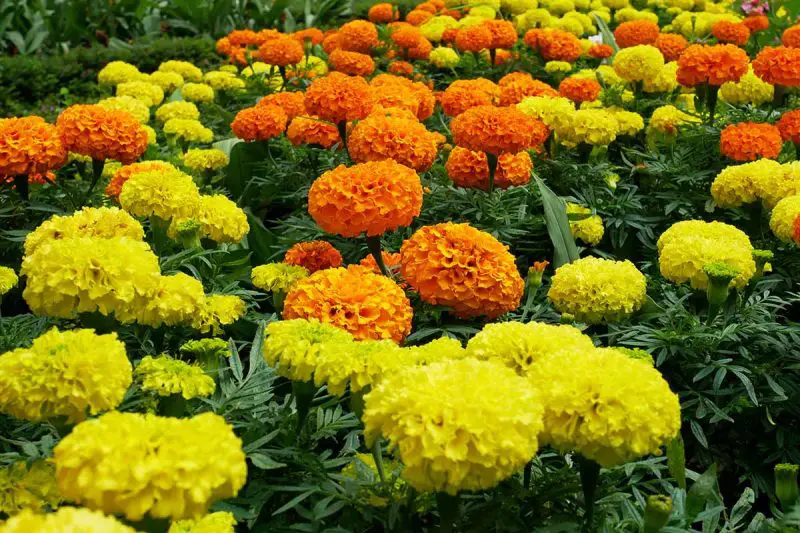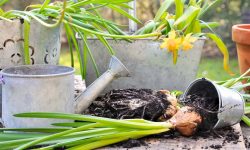There’s something undeniably joyful about a garden filled with marigolds. Their fiery shades of gold, orange, and deep red seem to capture the very essence of sunshine, radiating warmth and cheer in every bloom. For generations, gardeners have turned to marigolds not just for their beauty, but for the way they brighten borders, repel pests, and bring a sense of vibrancy that few other flowers can match.
But one question lingers in the minds of both beginners and seasoned gardeners alike: Are marigolds perennial flowers? Can these glowing blooms grace your garden year after year, or must they be replanted each season? In this heartfelt and practical guide, we’ll uncover the truth behind marigolds’ life cycle and share expert tips to help you enjoy their brilliant color for as long as possible—maybe even year-round.
Understanding the Marigold Life Cycle

What Is the Definition of a Perennial?
Perennial plants are those that live for more than two years, returning season after season without needing to be replanted. They typically go dormant in colder months and reemerge when temperatures rise again. Unlike annuals that live for a single season or biennials that live for two years, perennials are long-lived. They grow roots that survive underground during winter and sprout new growth from those roots each spring. Some famous perennials include peonies, daylilies, and lavender.
The Types of Marigolds
There are three primary types of marigolds commonly grown in home gardens: French marigolds (Tagetes patula), African marigolds (Tagetes erecta), and signet marigolds (Tagetes tenuifolia). French marigolds are compact and bushy, often used as bedding or border plants. African marigolds, also known as American marigolds, are taller and produce large, pom-pom-like flowers. Signet marigolds have a finer texture, edible flowers, and a citrusy aroma, often used in herb gardens. Despite their differences, all three types share one thing: they are frost-sensitive and complete their life cycle in one season in most climates.
Are Marigolds True Perennials?
Most marigold species are classified as tender annuals in the United States and similar climates. While technically herbaceous perennials in their native tropical or subtropical environments such as Mexico and Central America, they are not frost-tolerant. Once exposed to cold temperatures or frost, their stems and roots die off completely. Therefore, unless grown in protected or frost-free areas, marigolds must be replanted every year. However, in year-round warm climates, they can live longer and act more like perennials.
Regional Differences: Marigolds as Annuals vs. Perennials
Growing Zones Matter
Your USDA Hardiness Zone plays a crucial role in determining whether marigolds behave as annuals or perennials. In warmer regions—particularly Zones 9 through 11—temperatures rarely dip below freezing. In these climates, marigolds can grow continuously throughout the year. Their root systems don’t die back, and the plants may keep blooming across seasons with only minimal care. Gardeners in places like southern Texas, Florida, or southern California often treat marigolds as short-lived perennials, cutting them back lightly after flowering to encourage fresh growth and longer-lasting color.
In such zones, even if marigolds slow down during the coolest months, they often rebound quickly with the return of warmth and sunshine. Some varieties, especially the more robust African marigolds, may flower nearly nonstop if deadheaded regularly and kept well-fed.
Marigolds in Cooler Climates
In Zones 1 through 8, winter temperatures drop below freezing, making it nearly impossible for marigold plants to survive outdoors. As a result, marigolds are grown as annuals in these areas—planted in spring and removed after the first hard frost. Once exposed to freezing temperatures, the entire plant typically dies, including its roots.
However, some gardeners in cooler climates have had surprising success with marigolds returning in spring when grown in protected areas. These microclimates—such as south-facing walls, raised beds with excellent drainage, or areas with thick mulch—can offer just enough shelter to help certain plants survive an unusually mild winter.
Still, what appears to be a marigold returning from the previous season is often a self-seeded plant. If you allow marigolds to set seed in fall, those seeds may overwinter in the soil and sprout naturally once the soil warms in spring. While it’s technically a new plant, this natural reseeding can make marigolds seem like perennials, giving you color year after year without replanting.
Tips to Extend Marigold Bloom and Lifespan
Deadhead Regularly
Deadheading marigolds is one of the simplest yet most effective ways to keep them blooming for as long as possible. By regularly removing faded or spent blooms, you redirect the plant’s energy away from seed production and back into creating new flowers. This not only keeps the marigold looking neat and vibrant but also significantly extends its flowering period. The best time to deadhead is as soon as the petals begin to wilt and lose color. Gently pinch or snip the old bloom back to the nearest leaf node or bud. For gardeners who deadhead every few days, marigolds can continue to bloom profusely from early summer all the way into the first frost.
Provide Ideal Growing Conditions
Marigolds flourish when given the right environment, and small changes can make a big difference in both bloom duration and plant health. Aim to plant marigolds in a location where they’ll receive at least six hours of direct sunlight per day—the more sun, the better. These plants are sun-lovers, and insufficient light will lead to leggy growth and fewer blooms. The soil should be light, loose, and well-drained, ideally amended with compost to boost organic matter. Avoid overly rich or clay-heavy soils, as these can retain too much moisture, increasing the risk of root rot or fungal disease.
Consistent watering also supports vigorous growth. Although marigolds are known for tolerating short periods of drought once established, they prefer a regular watering routine. Deep watering once or twice per week encourages strong root systems, especially during dry spells. Applying a thin layer of organic mulch—such as shredded bark or straw—helps regulate soil moisture and temperature, while also suppressing weed competition.
Fertilize Sparingly
Too much fertilizer can do more harm than good when it comes to marigolds. These flowers are naturally robust and don’t require frequent feeding. In fact, over-fertilizing—particularly with high-nitrogen formulas—can lead to lush foliage but disappointingly few flowers. Instead, opt for a balanced fertilizer (like 10-10-10 or 5-10-5) diluted to half strength. Apply it every four to six weeks during the growing season for best results.
If you prefer a more organic approach, incorporate compost or aged manure into the soil at planting time. This provides a slow, steady nutrient release throughout the season. For container-grown marigolds, you may need to fertilize a bit more often, as nutrients can leach out with frequent watering. However, always err on the side of caution—moderation is key to promoting more blooms without overwhelming the plant.
Growing Marigolds Year-Round in Warm Climates
Capitalize on Continuous Bloom Cycles
In warm climates where frost is rare or nonexistent, marigolds can reward gardeners with near year-round blooms. These sun-loving flowers don’t need a dormancy period like many other plants. Instead, with regular maintenance, they’ll keep producing vibrant flowers month after month. Deadhead faded blooms often to redirect energy into new buds. Refresh the soil every couple of months with compost or organic fertilizer to replenish nutrients. Consistent watering—without overwatering—ensures strong roots and sustained blooming, making your garden a cheerful sight throughout the seasons.
Prune to Rejuvenate Plants
Marigolds can become leggy or straggly over time, especially after a long blooming period. Strategic pruning every few months helps them stay bushy and compact. Trim back about one-third of the plant, ideally after a flush of blooms. This encourages fresh branching and a new round of flowering. Pruning not only improves the shape and appearance of the plant but also promotes air circulation, which reduces the chances of mildew or fungal issues during humid or rainy spells. Regular rejuvenation keeps marigolds vigorous and lush throughout the year.
Watch for Pests and Diseases
Even though marigolds are known for their pest-repelling qualities, they’re not completely immune to infestations. Aphids, spider mites, and thrips can occasionally settle in, especially during hot, dry stretches. Fungal issues like powdery mildew may appear in damp or overcrowded conditions. Check the undersides of leaves and around the base of the plant regularly. If pests are spotted early, natural remedies like neem oil, insecticidal soap, or even a strong spray of water can often resolve the issue. Keeping your plants clean, trimmed, and well-ventilated is the best defense for year-round health.
Strategies to Enjoy Marigolds Across All Seasons
Start Seeds Indoors
Starting marigold seeds indoors is a practical strategy for gardeners who want early blooms or live in regions with a shorter growing season. Begin 6 to 8 weeks before your region’s last expected frost date. Use clean seed trays or biodegradable pots filled with a sterile seed-starting mix to minimize disease risk. Sow the seeds just below the surface and lightly moisten the soil. Place the containers in a bright, warm space—ideally around 70°F (21°C)—or use a heat mat and grow lights to provide ideal germination conditions. Once seedlings have developed at least two sets of true leaves, begin hardening them off by gradually introducing them to outdoor conditions over 7 to 10 days. This process ensures they adapt smoothly to the outdoor environment, leading to a stronger transplant and a head start on continuous flowering once planted in the garden.
Succession Planting
Succession planting is a simple yet powerful technique to maintain vibrant marigold displays throughout the season. Instead of planting all your seeds or transplants at once, stagger your sowings every two to four weeks from spring until mid-summer. This staggered approach ensures you’ll always have fresh, healthy plants coming into bloom just as older ones begin to fade or go to seed. It’s especially effective in climates where the growing season is long, such as Zones 8–11. Succession planting also allows you to experiment with different marigold varieties—French, African, or signet—so your beds feature a variety of colors, shapes, and sizes all year long. This method keeps your flower beds dynamic and full of life even as individual plants come and go.
Collect and Save Seeds
Seed-saving is a cost-effective and rewarding way to extend your marigold enjoyment into future seasons. Toward the end of summer or early fall, allow a few flower heads to remain on the plant and dry naturally. Once fully brown and crisp, gently remove the dried flower heads and break them open to reveal long, slender seeds that are dark with pale tips. Choose seeds from the healthiest, most floriferous plants for better performance next year. After collecting, spread the seeds out in a single layer to dry completely before storing. Label your seed envelopes or airtight containers with the variety and collection date, then store them in a cool, dry, dark place. Properly stored, marigold seeds can remain viable for up to two years. Saving seeds not only saves money—it also helps you cultivate varieties that thrive particularly well in your garden’s specific conditions.
Marigold Varieties That Perform Like Perennials
Tagetes Lemmonii
Tagetes lemmonii, also known as Copper Canyon daisy or Mexican bush marigold, stands out for its perennial nature in warmer climates. Native to the highlands of Mexico and Arizona, this vigorous species thrives in USDA Zones 8 to 11 and performs best in full sun and well-draining soil. Its deeply divided, aromatic foliage releases a pungent citrusy scent when brushed—often acting as a natural pest deterrent.
This marigold relative blooms in a profusion of golden-yellow daisy-like flowers in fall and early spring, sometimes even year-round in frost-free areas. Once established, it requires minimal watering, making it ideal for xeriscaping and low-maintenance gardens. Though frost-sensitive, it can bounce back from light freezes with a hard pruning. In colder climates, it may die back but can be grown in containers and moved indoors over winter.
Self-Seeding French Marigolds
French marigolds (Tagetes patula) aren’t technically perennials, but their remarkable ability to reseed makes them behave as if they are—especially in USDA Zones 8 and up. These compact, bushy marigolds produce abundant seeds that easily fall to the soil and sprout the following season. If you allow the spent blooms to dry naturally on the plant, they’ll often drop their seeds in late summer and early fall.
To encourage successful self-seeding, avoid heavy mulching directly over the marigolds after the first frost, and refrain from disturbing the soil too much in early spring. In colder climates, you can mimic this process by harvesting the seeds in fall and sowing them outdoors in early spring. Some gardeners even find volunteer seedlings sprouting up in sidewalk cracks and raised beds, showing how resilient French marigolds can be.
African Marigolds in Greenhouses
African marigolds (Tagetes erecta), known for their tall stature and oversized, pompom blooms, are typically treated as annuals—but with greenhouse care, they can persist through winter. In USDA Zones below 9, you can pot up your healthiest African marigold plants and bring them into a heated greenhouse or sunny indoor space before the first frost.
To overwinter African marigolds successfully, provide them with ample sunlight (or grow lights), well-drained soil, and keep them on the drier side to prevent rot. Prune back spent flowers and leggy growth to encourage compact regrowth. Some plants may enter a semi-dormant state in winter, reducing flowering, but will resume vigorous growth and blooming in spring once daylight hours increase. This method lets you enjoy African marigolds as “tender perennials” in colder regions and get a head start on next year’s blooms.
Container Gardening with Marigolds
Portable Protection in Cold Weather
One of the greatest advantages of growing marigolds in containers is mobility. As temperatures begin to dip, especially in fall or during unexpected cold snaps, containers can be easily moved indoors, into greenhouses, or under sheltered patios. This protects the plants from frost damage and allows gardeners in USDA Zones 6–8 to potentially overwinter marigolds that would otherwise not survive. Even a sunny windowsill or enclosed porch can help extend the marigold’s growing season, giving it a chance to bounce back once warmer weather returns. Container gardening thus becomes a strategic way to “cheat” the cold and keep your marigolds blooming for longer.
Refreshing Container Soil
Marigolds are heavy feeders, and soil nutrients can quickly deplete in pots. At the beginning of each new growing season, remove the top 2–3 inches of soil and replace it with a fresh layer rich in compost or organic fertilizer. This rejuvenates the growing medium and provides a nutrient boost to help spark new growth. Every two to three years, it’s beneficial to repot the plant entirely. Choose a slightly larger container, refresh all the soil, and trim any circling roots. Always use a well-draining potting mix—ideally one that contains perlite, compost, and peat or coconut coir. Drainage holes are a must to prevent root rot, which marigolds are prone to in soggy conditions.
Combine with Perennial Companions
Container marigolds shine when combined with compact, perennial herbs and flowers. Try planting them alongside lavender, rosemary, creeping thyme, or ornamental grasses for a lush and textured look. These plants not only complement marigolds visually but also offer pest-repelling benefits and attract pollinators like bees and butterflies. Many herbs thrive under the same sun-loving, well-drained conditions that marigolds prefer. When mixing perennials and marigolds in a pot, ensure each plant’s water and light needs are compatible. This combination strategy results in containers that stay attractive longer into the season and may even return year after year if overwintered properly.
Common Misconceptions About Marigold Longevity
Myth: All Marigolds Are Annuals
While commonly grown as annuals, not all marigolds are strictly limited to one-season life cycles. In USDA Zones 9–11 and other frost-free regions, marigolds—especially varieties like Tagetes lemmonii—can act more like short-lived perennials, returning year after year with minimal effort. Even French and African marigolds may overwinter successfully in warm climates with some protection. Gardeners in cooler areas often assume these plants must be discarded, but overwintering indoors or in greenhouses can extend their life well beyond a single season. The “annual” label often reflects convenience and climate, not biological necessity.
Myth: Marigolds Can’t Survive Indoors
Although marigolds are sun-loving, outdoor plants by nature, they can survive and even thrive indoors with the right conditions. Sufficient light is critical—without at least 6–8 hours of bright sunlight or full-spectrum grow lights, marigolds may become leggy and weak. Well-drained soil and moderate watering help prevent root rot and mildew, common indoor threats. To promote compact growth and continuous blooms, trim leggy stems and remove spent flowers regularly. With consistent care, indoor marigolds can brighten windowsills year-round and even bloom through winter.
Myth: Marigolds Don’t Need Attention
While marigolds are famously easy to grow, they still benefit from thoughtful maintenance. Regular deadheading promotes new buds and extends flowering. Occasional pruning improves airflow and prevents fungal issues, especially in humid environments. Though marigolds tolerate poor soil, a light application of balanced fertilizer every few weeks can enhance their performance. Also, despite their natural resistance to many pests, marigolds aren’t immune—aphids, spider mites, and powdery mildew can still appear. Gardeners who ignore these issues may find their plants struggling before the season ends. A little care goes a long way in ensuring long-lived, lush marigolds.
Encouraging Marigold Blooms Through the Seasons
Late Summer Boosting
As temperatures rise and marigolds mature, their early vigor may fade, leading to fewer blooms and leggier growth. To reinvigorate plants in late summer, lightly trim back stems that have become tall and sparse to encourage bushier growth. Remove faded flowers through deadheading to signal the plant to produce more blooms instead of setting seed. Follow up with a deep watering session to relieve drought stress and restore turgor to the leaves.
Additionally, apply a slow-release fertilizer or a diluted liquid feed high in phosphorus to promote bud development. For an organic option, mix in compost tea or worm castings around the base. This mid-season care routine can often trigger a dramatic second flush of color, keeping marigolds blooming well into autumn.
Fall Care and Cleanup
When the days shorten and nighttime temperatures drop, marigolds respond by slowing their growth and bloom production. To make the most of the fall season, inspect plants for any fungal spots or pest issues and promptly remove affected leaves or flowers. Collect seeds from dry, brown flower heads by gently breaking them open and storing the seeds in labeled paper envelopes in a cool, dry place for planting next spring.
In warmer USDA zones (8–11), apply a 2- to 3-inch layer of organic mulch such as straw, shredded leaves, or compost around the base of your marigolds to retain soil warmth and moisture. This may allow the plants to continue blooming or even overwinter in mild climates. In colder zones, marigolds typically die back with the first hard frost. Cut down the spent plants, remove debris to prevent disease buildup, and compost healthy material to enrich next year’s soil.
Winter Strategies
In most climates, marigolds do not survive freezing temperatures outdoors. Winter care, therefore, becomes more about preparation than preservation. Start by cleaning and sterilizing used containers and tools to eliminate overwintering pests or pathogens. Sort and organize collected seeds, noting any standout performers you’d like to regrow next season.
If you enjoy indoor gardening, try overwintering marigolds in containers placed near a sunny south- or west-facing window. Supplement with grow lights if needed to maintain at least 12–14 hours of light per day. Keep temperatures between 60–70°F (15–21°C) and reduce watering slightly, as growth slows in lower light. Occasionally pinch back growth to prevent legginess and continue feeding every 4–6 weeks with a gentle, balanced fertilizer. These steps can help marigolds stay attractive indoors and provide a burst of color even during winter’s dreariest days.
Frequently Asked Questions About Marigolds
Can I grow marigolds indoors year-round?
Yes, marigolds can thrive indoors year-round if provided with sufficient light—at least 6 hours of direct sunlight or a full-spectrum grow light daily. Choose compact varieties like French marigolds, which adapt better to containers. Use well-draining potting soil, maintain temperatures between 65–75°F (18–24°C), and water only when the top inch of soil dries out. Monthly feeding with a balanced liquid fertilizer supports continuous blooms indoors.
Do marigolds reseed themselves?
French marigolds often self-seed, especially if you allow spent blooms to remain and dry on the plant. In USDA Zones 8–10, seeds dropped naturally can sprout the following season without intervention. Deadheading can reduce self-seeding, so leave a few blooms to mature fully if you want natural regrowth. However, hybrid varieties may not grow true to type from self-sown seeds.
What’s the best time to plant marigolds?
Marigolds should be planted outdoors after the danger of frost has passed and when soil temperatures rise above 60°F (15°C). In most regions, this is in mid to late spring. For earlier flowering, start seeds indoors 6–8 weeks before the last expected frost, then harden off the seedlings before transplanting. Container-grown plants can also be gradually acclimated outdoors as temperatures warm.
Can marigolds survive a light frost?
No, marigolds are highly frost-sensitive and cannot tolerate even a light frost. Their tropical origins mean cold snaps can blacken leaves or kill the plant outright. If a surprise frost is forecasted, protect them with garden fabric or cloches overnight. For potted marigolds, move them indoors or to a sheltered location until conditions stabilize.
Are there marigold types better suited to perennial behavior?
Yes, Tagetes lemmonii, also known as Mexican bush marigold, is a true perennial in USDA Zones 8–11 and can grow into a large, shrub-like form with golden-orange blooms. French marigolds (Tagetes patula), while technically annuals, may reseed prolifically in frost-free or mild winter regions, creating the illusion of perennial behavior. In warmer climates, gardeners often report marigolds returning each year without needing replanting.
Conclusion
Marigolds may not always be true perennials, but their fiery beauty, resilience, and ability to reseed make them feel like faithful companions in the garden year after year. Whether you’re in a warm climate where Tagetes lemmonii thrives as a perennial, or in cooler zones where annual marigolds glow brilliantly for one long season, these flowers never fail to bring vibrant joy and effortless charm to your space.
With a little knowledge and care, you can extend their bloom, encourage reseeding, or even grow them indoors for year-round sunshine. Marigolds don’t just brighten gardens—they brighten hearts. So whether you’re sowing seeds in spring or tucking potted plants near a sunny window in winter, marigolds will always reward you with color, warmth, and a sense of connection to the rhythms of nature. Keep growing, keep learning, and let your garden glow—season after season.






